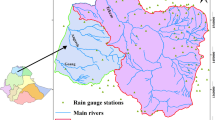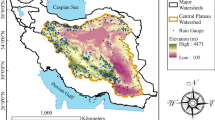Abstract
Rain gauges are installed to measure pointwise precipitation and provide a comprehensive perspective of its spatiotemporal variations. Selection of an efficient and reliable rainfall monitoring network is a key role to reduce its maintenance and handling cost. The main purpose of the current paper is to compare efficiencies of various network design methods. The applied methods are entropy theory (as probabilistic multi-criteria decision-making) and genetic algorithm (as one of the heuristic methods) with three objective functions. Also, two classical (ordinary kriging; OK) and modern (Bayesian maximum entropy; BME) spatial simulation methods were undertaken to provide a comprehensive spatial simulation of precipitation. The proposed assessment was applied on spatial mean annual precipitation variability in the Namak Lake watershed located in the central part of Iran. The final efficiency of developed network design methods is evaluated in terms of three criteria known as mass estimation error, total error, and spatial bias of estimated rainfall. Based on the results, different network distributions have been proposed by the methods. Despite the reliability of the heuristic approach in nonlinear optimization due to its mathematical principle, the results indicated that the network design based on entropy theory can be used to estimate long-term mean annual precipitation more reliably and accurately. Results of the mass estimation error have shown 78 and 83% superiority of the entropy theory approach from the worst approach obtained from the OK and BME methods, respectively.













Similar content being viewed by others
References
Abedini MJ, Nasseri M, Ansari A (2008) Cluster-based ordinary kriging of piezometric head. J Hydrol 351:360–367
Adhikary SK, Yilmaz AG, Muttil N (2014) Optimal design of rain gauge network in the middle Yarra River catchment, Australia. Hydrol Process 29(11):2582–2599
Al-Zahrani M, Husain T (1998) An algorithm for designing a precipitation network in the south-eastern region of Saudi Arabia. J Hydrol 205:205–216
Barca E, Passarella G, Uricchio V (2008) Optimal extension of the rain gauge monitoring network of the Apulian regional consortium for crop protection. Environ Monit Assess 145(1–3):375–386
Bashir B, Fouli H (2015) Studying the spatial distribution of maximum monthly rainfall in selected regions of Saudi Arabia using geographic information systems. Arab J Geosci 8(11):9929–9943
Bayat B, Zahraie B, Taghavi F, Nasseri M (2012) Evaluation of spatial and spatiotemporal estimation methods in simulation of precipitation variability patterns. Theor Appl Climatol 113(3–4):429–444
Bayat B, Nasseri M, Naser G (2014) Improving Bayesian maximum entropy and ordinary kriging methods for estimating precipitations in a large watershed: a new cluster-based approach. Can J Earth Sci 51(1):43–55
Chadalavada S, Datta B, Naidu R (2011) Uncertainty based optimal monitoring network design for a chlorinated hydrocarbon contaminated site. Environ Monit Assess 173(1–4):929–940
Chebbi A, Bargaoui Z, Cunha M (2011) Optimal extension of rain gauge monitoring network for rainfall intensity and erosivity index interpolation. J Hydrol Eng 16(8):665–676
Chen YC, Wei C, Yeh HC (2008) Rainfall network design using kriging and entropy. Hydrol Process 22:340–346
Cheng K-S, Lin Y-C, Kiou J-J (2008) Rain-gauge network evaluation and augmentation using geostatistics. Hydrol Process 22:2554–2564
Choubin B, Zehtabian G, Azareh A, Rafiei-Sardooi E, Sajedi-Hosseini F, Kişi Ö (2018) Precipitation forecasting using classification and regression trees (CART) model: a comparative study of different approaches. Environ Earth Sci 77(8):314
Christakos G, Bogaert P, Serre ML (2002) Temporal GIS. Springer-Verlag Press, New York
Cressie N (1985) Fitting variogram models by weighted least squares. Math Geol 17(5):563–586
Dong X, Dohmen-Janssen CM, Booij MJ (2005) Appropriate spatial sampling of rainfall or flow simulation. Hydrol Sci J 50(2)
Gamma Design Software (2001) GS+ user’s guide version 5.1.1. Gamma Design Software, Plainwell
Goldberg DE (1989) Genetic algorithms in search, optimization and machine learning. Addison Wesley, Reading
Haggag M, Elsayed AA, Awadallah AG (2016) Evaluation of rain gauge network in arid regions using geostatistical approach: case study in northern Oman. Arab J Geosci 9(9):552
Izady A, Abdalla O, Ahmadi T, Chen M (2017) An efficient methodology to design optimal groundwater level monitoring network in Al-Buraimi region, Oman. Arab J Geosci 10(2):26
Jing C, Yu J, Dai P, Wei H, Du M (2016) Rule-based rain gauge network design in urban areas aided by spatial kernel density. Water Practice Technol 11(1):166–175
Kitanidis PK (1997) Introduction to geostatistics: applications to hydrogeology. Cambridge University Press, Cambridge
Mogheir Y, De Lima JLMP, Singh VP (2009) Entropy and multi-objective based approach for groundwater quality monitoring network assessment and redesign. Water Resour Manag 23(8):1603–1620
Mogheir Y, Singh VP, de Lima JLMP (2006) Spatial assessment and redesign of a groundwater quality monitoring network using entropy theory, Gaza strip, Palestine. Hydrogeol J 14(5):700–712
Motulsky HJ (1999) Analysing data with GraphPad Prism. GraphPad Software. San Diego, http://www.graphpad.com
Nasseri M, Zahraie B (2010) Application of simple clustering on space-time mapping of mean monthly rainfall pattern. Int J Climatol 31(5):732–741
Narany TS, Ramli MF, Fakharian K, Aris AZ, Sulaiman WNA (2015) Multi-objective based approach for groundwater quality monitoring network optimization. Water Resour Manag 29(14):5141–5156
Olea RA (1999) Geostatistics for engineers and earth scientists. Kluwer Academic Publishers, Boston
Reed PM, Minsker BS, Valocchi AJ (2000) Cost effective long-term groundwater monitoring design using a genetic algorithm and global mass interpolation. Water Resour Res 36(12):3731–3741
Rodriguez-Iturbe I, Mejia JM (1974) The design of rainfall networks in time and space. Water Resour Res 10(4):713–728
Shafiei M, Ghahraman B, Saghafian B, Pande S, Gharari S, Davary K (2014) Assessment of rain-gauge networks using a probabilistic GIS based approach. Hydrol Res 45(4–5):551–562
Shaghaghian MR, Abedini MJ (2013) Rain gauge network design using coupled geostatistical and multivariate techniques. Scientia Iranica 20(2):259–269
Sophocleous M (1983) Groundwater observation network design for the Kansas groundwater management districts, USA. J Hydrol 61:371–389
Thiessen AH (1911) Precipitation averages for large areas. Mon Weather Rev 39(7):1082–1089
Wadoux AMC, Brus DJ, Rico-Ramirez MA, Heuvelink GB (2017) Sampling design optimisation for rainfall prediction using a non-stationary geostatistical model. Adv Water Resour 107:126–138
Xu H, Xu CY, Sælthun NR, Xu Y, Zhou B, Chen H (2015) Entropy theory based multi-criteria resampling of rain gauge networks for hydrological modelling—a case study of humid area in southern China. J Hydrol 525:138–151
Xu P, Wang D, Singh VP, Wang Y, Wu J, Wang L, Zou X, Liu J, Zou Y, He R (2018) A kriging and entropy-based approach to raingauge network design. Environ Res 161:61–75
Yeh HC, Chen YC, Chiang W, Chen RH (2011) Entropy and kriging approach to rainfall network design. Paddy Water Environ 9:343–355
Yoo C, Jung K, Lee J (2008) Evaluation of rain gauge network using entropy theory: comparison of mixed and continuous distribution function applications. J Hydrol Eng 13(4):226–235
Author information
Authors and Affiliations
Corresponding author
Appendix. Successive steps of network design based on entropy theory
Appendix. Successive steps of network design based on entropy theory
-
Step 1
Data collection and analysis. In this step and after checking for homogeneity, the annual precipitations in each rain gauge stations were averaged over 30 years of the registration period to attain long-term mean annual precipitations.
-
Step 2
Measurement of transinformation and distance. The transinformation and distance were calculated for each pair of the existing rain gauges. To obtain transinformation, which requires the calculation of marginal entropy and joint entropy, a contingency table should be provided.
-
Step 3
Plotting of the T-D curve. Transinformation values were drawn versus distances known as experimental T-D values (Fig. 12). To fit a theoretical T-D curve to experimental T-D values, different function structures were tested to achieve the best fit. These calculations were applied in GRAPHPAD PRISM statistical software using the least square fitting procedure (Motulsky 1999). Finally, the best curve was chosen in terms of R2 and MAE. Results, which will be presented in the results section, have been shown the superiority of the exponential decay curve which has the following function structure:
where T0 is the initial value of transinformation, K is the transinformation decay rate, Tmin is the minimum transinformation value, and d is the distance between rainfall stations. The plot of the exponential decay curve with its parameters is shown in Fig. 12. In this figure, the distance value L is called range in which the transinformation reaches its lowest value. Accurate estimation of range (L) plays a fundamental role in optimal positioning of rainfall stations. It can be calculated by the following equation (Mogheir et al. 2006):
where ɛ is the constant number (error term).
The percentage of the net redundant information (%NRI), which is the criterion to evaluate redundant information, is computed as:
-
Step 4
Obtaining of square grid size. After determining the L value, the optimum grid size is calculated based on the square block with a and 0.5 L length and diagonal sizes, respectively (Sophocleous 1983; Olea 1999). Figure 13 shows the schematic of a regular square grid. The recommended grid size is obtained as:
-
Step 5
Fitting of the best grid network. Since the superimposing of the grid (with grid size obtained in a previous step) on spatial distribution of stations results in various configurations of the rain gauge network, the fitting of the best grid is of great importance. To achieve this goal, different grids were tested and the best one was selected in terms of minimum summation area of boundary cutting cells. It means that, after fitting a regular square network to the watershed, the area of boundary cut cells are calculated and the best grid network is chosen based on the minimum area. This procedure was applied in the geographical information system (GIS).
-
Step 6
Selection of a rain gauge per square block. In the last step of the methodology, the stations were positioned through the optimum grid network obtained in the previous step. There was more than one station in some cells. The numbers were reduced by superimposing a square block over the study area and selecting one station per square block in a stratified way. In the following paragraph, the approach to determine the most convenient station based on the geostatistical framework is described.
The fundamental key to geostatistical estimation of mean annual precipitation is the calculation of the degree of spatial dependency which is expressed by a variogram model. Variogram modeling consists of two major parts known as experimental and theoretical variograms. Experimental variograms/cross variograms were calculated based on the observations in rain gauges. Primary fitting of theoretical and experimental variograms was carried out by GS+ software (Gamma Design Software, 2001). For this purpose, the model (e.g., exponential, Gaussian, spherical, etc.) and its parameters (nugget, sill, and range) were selected based on the maximum correlation coefficient. Then, these primary parameters of theoretical variograms were optimized using iterated nonlinear weighted least squares (INLWLS) method to guarantee the best fit to the experimental variograms (Cressie 1985). Finally, after defining the optimum structure of theoretical variograms, their covariance models were used for estimation purpose. Application of the geostatistical method reveals the best station in each cell and the optimum position and numbers of rain gauges is obtained.
Rights and permissions
About this article
Cite this article
Bayat, B., Nasseri, M., Hosseini, K. et al. Revisited rainfall network design: evaluation of heuristic versus entropy theory methods. Arab J Geosci 11, 561 (2018). https://doi.org/10.1007/s12517-018-3915-6
Received:
Accepted:
Published:
DOI: https://doi.org/10.1007/s12517-018-3915-6




